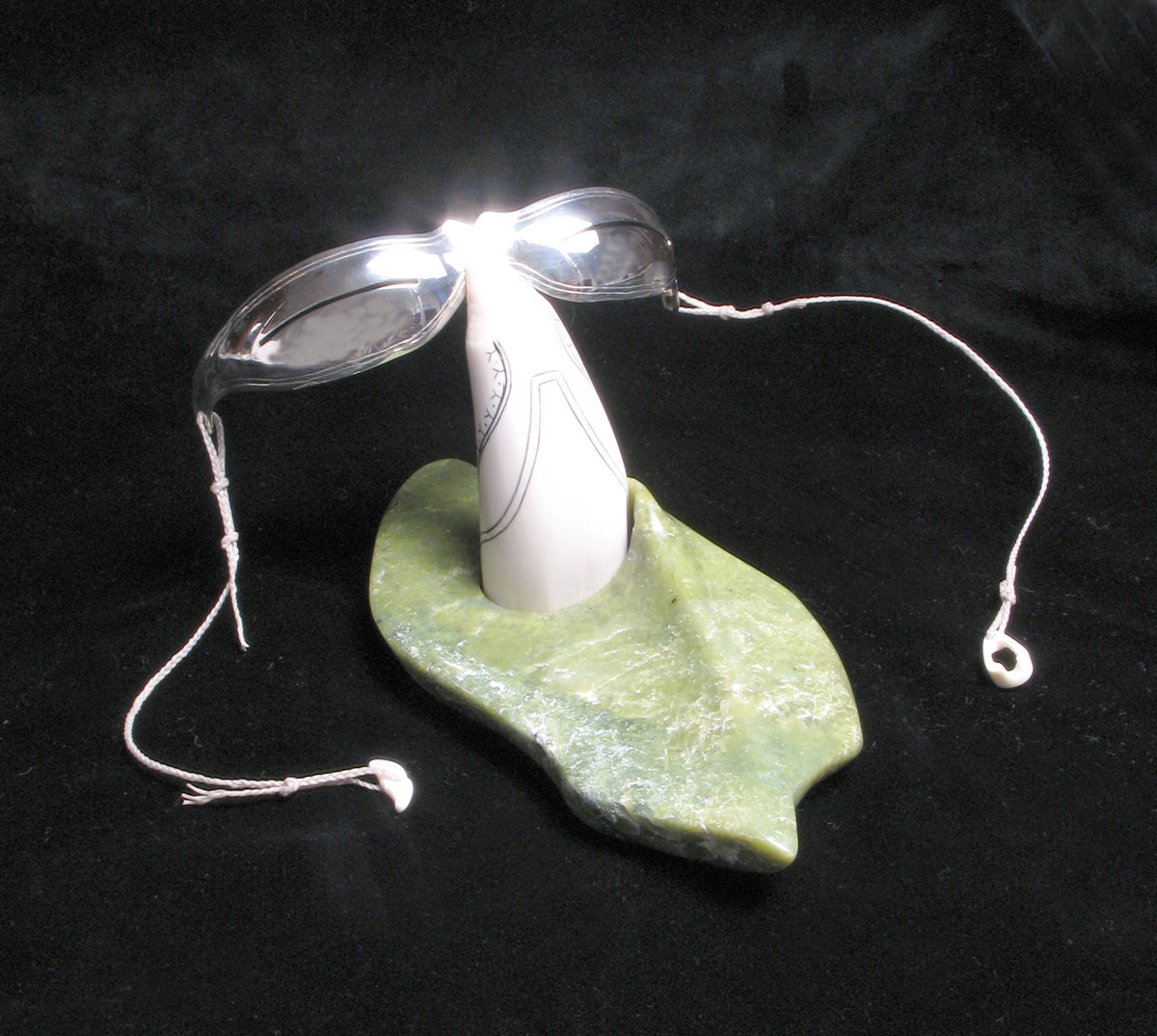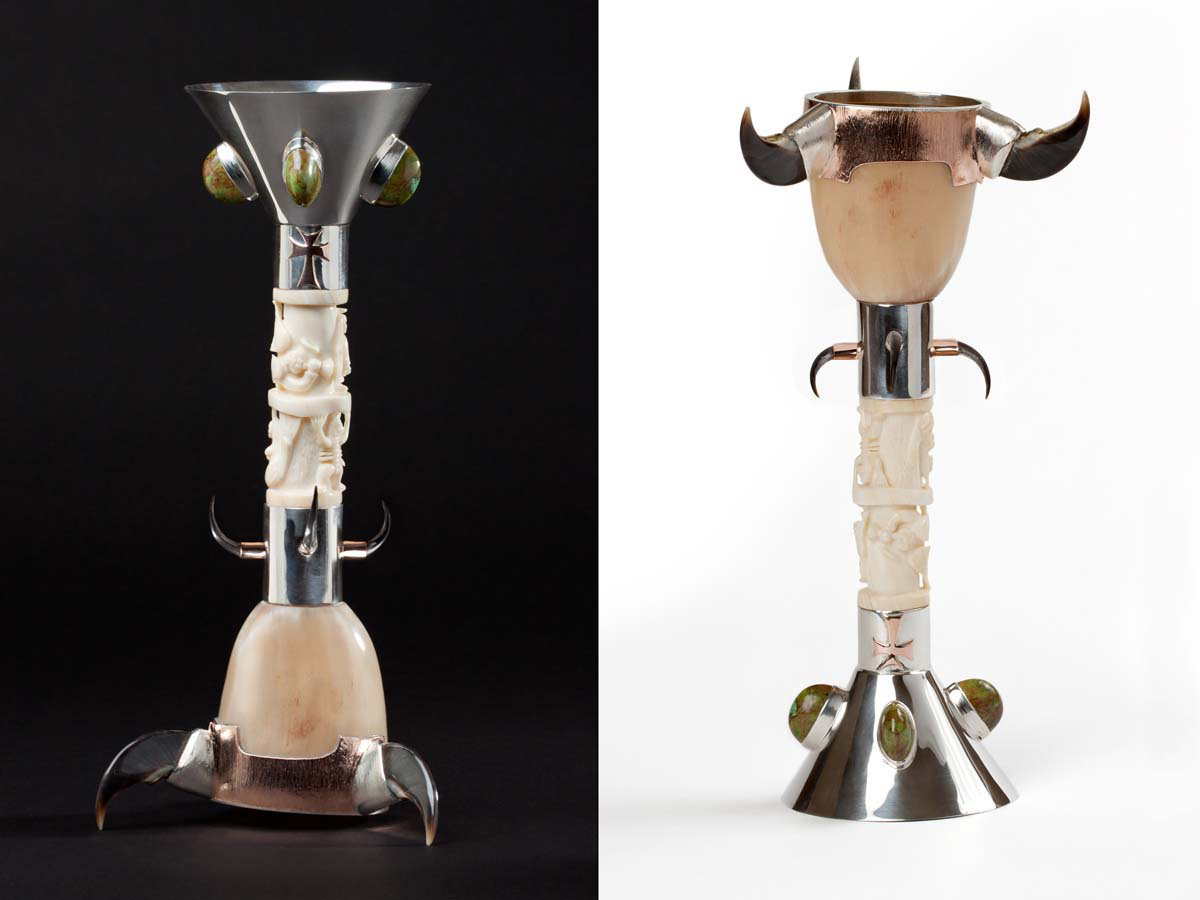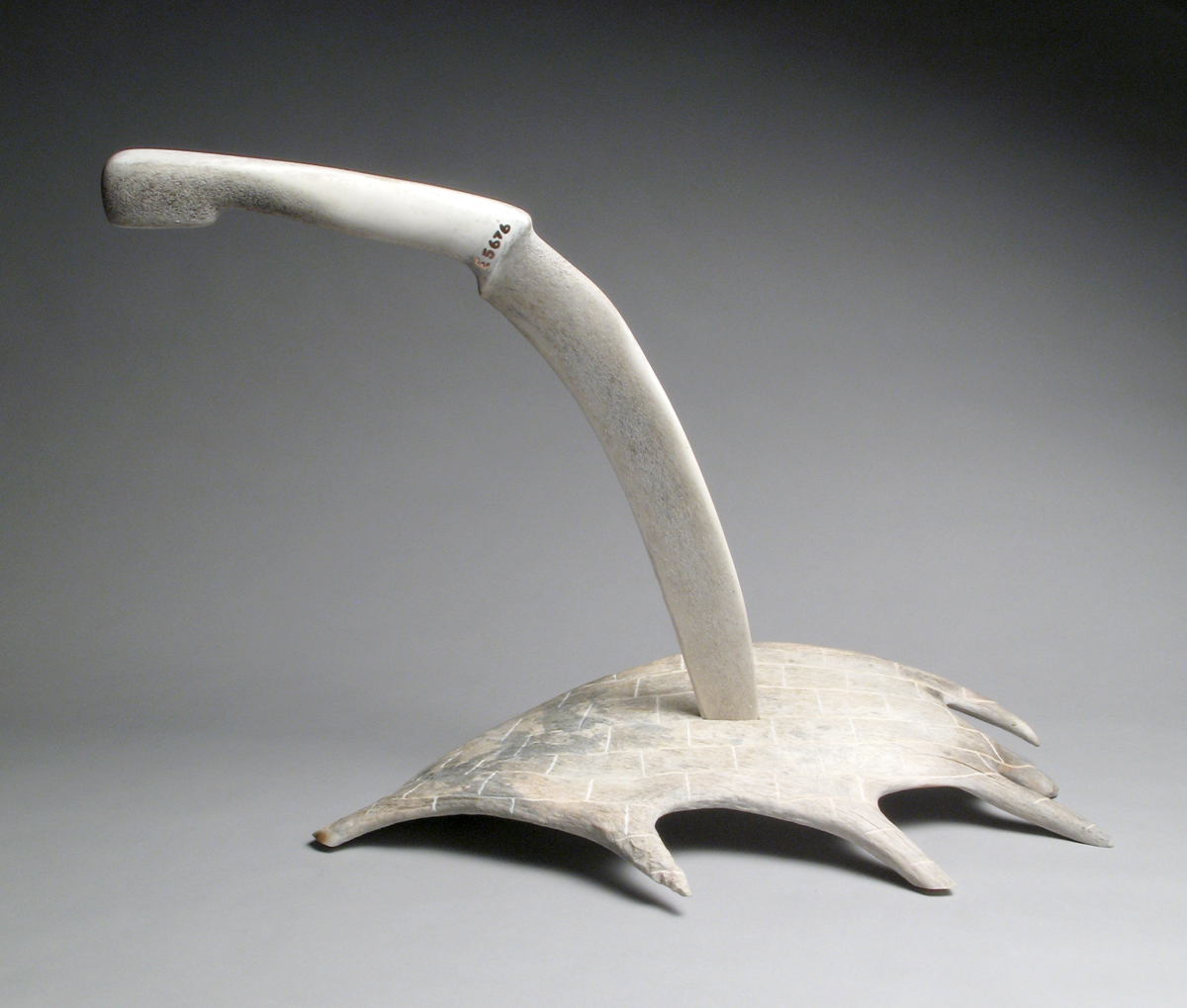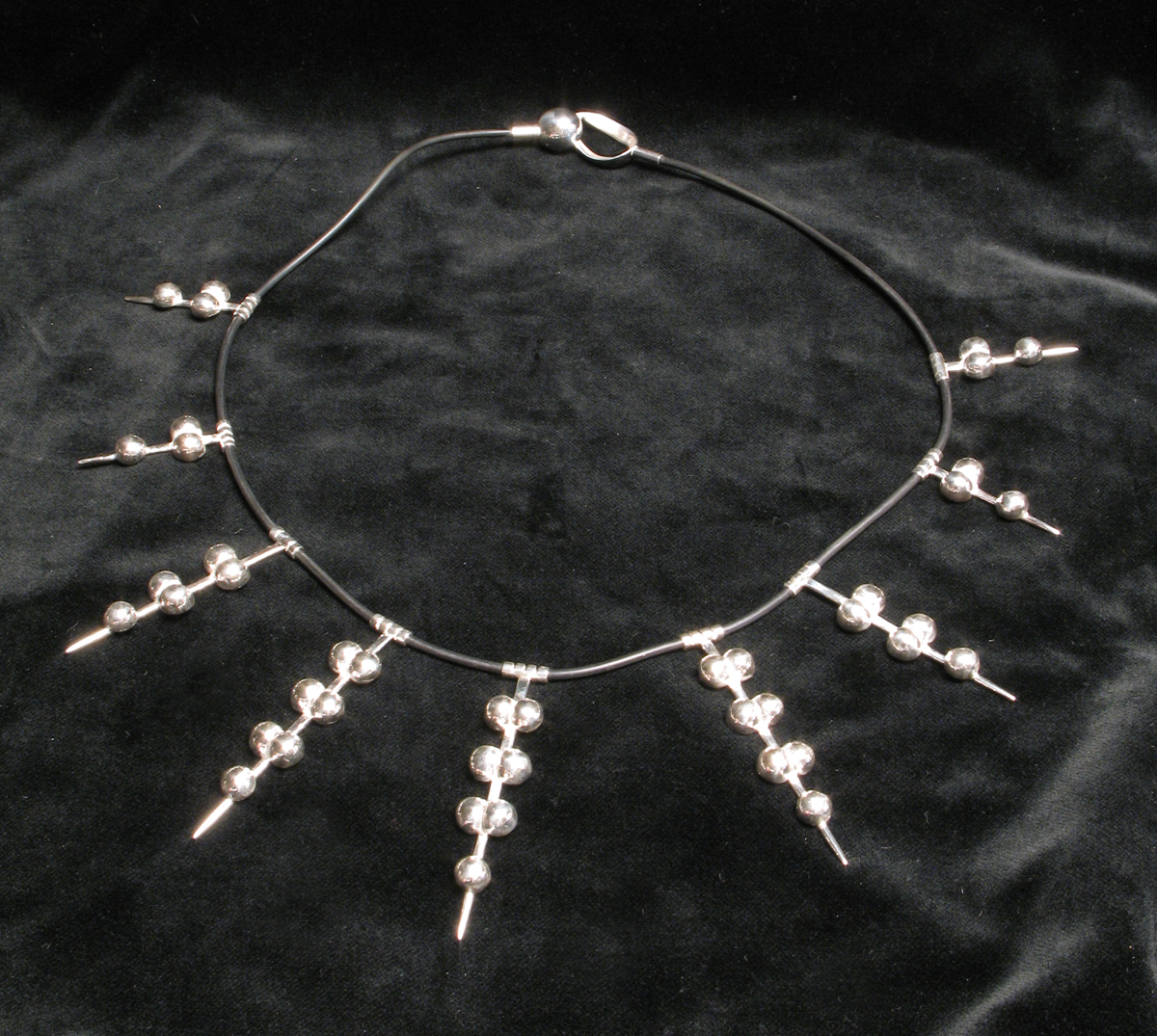
SNOW GOGGLES ON BASE, Mathew Nuqingaq, Iqaluit 2010, Sterling silver, sinew, ivory, stone 5 x 6 x 8″
Exhibition opened May 28, 2011
Aayuraa means snow-goggles in Inuktitut, the Inuit language. As the purpose of snow goggles is to protect one’s vision, it is a fitting name for an establishment that cares for and fosters the vision of artists. Inuit art is often associated with fine, small, intricately fashioned work. From the detailed etched scenes on walrus ivory, to precious amulets and miniature ivories, and the fine lines of etchings and stonecuts, there is a strong history of producing finely detailed work in the North. Today, Inuit artists are applying their talent to metal work and jewellery, and the results are marvellous. The artists of the Aayuraa Studio work in a creative, supportive, and cooperative environment. They lean on each other for inspiration and guidance. This studio has yielded incredible results that show the artists are exploring, experimenting and challenging themselves. As a result, the jewellery and metalwork are innovative with a balance of traditional flare and twenty-first century style.
This exhibition focuses on the Aayuraa Studio and highlights the innovative spirit of its artists. Specifically, the exhibit features the work of Mathew Nuqingaq, Ruben Komangapik, and Adrienne Stanton, among others. In an unprecedented presentation, the creativity of the North is bound with contemporary metal practices in a collection of new jewellery and metalwork. Mathew Nuqingaq, Ruben Komangapik and Adrienne Stanton were in attendance for the vernissage of the exhibition, which coincided with a symposium on Inuit art that took place at the Art Gallery of Ontario (April 2, 2011). Feheley Fine Arts is pleased to present the Aayuraa Studio and its artists in this exhibition dedicated entirely to jewellery and metalwork.
The Studio
The Aayuraa Studio is the invention of the Mathew Nuqingaq, an artist, jewellery-maker and teacher at the Arctic College program. In 2007, Nuqingaq converted an old building in Iqaluit into a working metal shop and studio for jewellery artists. In a group effort, Nuqingaq worked with fellow artists and friends Claude Roussel and Ruben Komangapik, to renovate and transform the old building into a working jewellery studio. In a spirit of resourcefulness, no usable material was overlooked and every piece was put to use—even old plane parts found a home!

SINS (SHAMANISM IS NOT SATANISM), Ruben Komangapik, Quebec 2010/11, Sterling silver, gaspeite, 14K red gold,, 11 x 3.75 x 4″
The studio has become a hub for artists. Nuqingaq is there daily mentoring and creating stunning pieces of jewellery, while artists such as Jamasie Teevee, Tim Pitsiulak, and Oopik Pitsiulak drop in and work there whenever they are in Iqaluit. The open door policy recalls the structure of artist co-ops or cultural centres, and the studio has hosted many crafts workshops. It continues to welcome artists from far and wide. There is no doubt that the collective character of the studio has contributed to a community environment. In Nuqingaq’s own words “[It’s] great to work with friends vs. working alone at home… everything flows really well. A lot of inspiration.”[1]
The Artists
Mathew Nuqingaq is the founder of the Aayuraa Studio. He is an artist, a silversmith, a photographer, an ice carver, and a teacher at the Nunavut Arctic College. His open-minded attitude reaches out to everyone he works with and this spirit infuses all of his work. Nuqingaq’s work bridges contemporary style with traditional Inuit imagery. Snow Goggles on Base treats the traditional theme of snow goggles in a modern way. Finely fashioned metal goggles shine in contrast to the incised ivory tusk that supports them on a stone base. Similarly, Comb Necklace evokes traditional Inuit culture with the comb shape and incised ivory. The form and pattern are also reminiscent of an amauti, the traditional women’s parka. Nuqingaq’s talents do not end with these incredible creations. He is also an accomplished drum dancer and his performance at the exhibition opening was an unexpected treat.
Ruben Komangapik melds traditional imagery with modern style in his sculptures. Komangapik does not shy away from difficult subject matter and many of his pieces address tough questions. In SINS (Shamanism is not Satanism) the artist presents the tension between Christianity and Shamanism. Every element of the composition is meaningful and deliberately selected. The beauty of the piece distracts the viewer from the controversial subject, while the presence of the sharp claws reminds us of the significant impact of the imposition of a faith on the Inuit. This is a (Inuit) Pipe is a reference to the artist’s grandfather. Again, the artist has created a sleek design for a traditional object. He described its significance in the following way:

FREEDOM, Ruben Komangapik, Pond Inlet/Quebec, 2010, Caribou and Moose antler, 14K gold, 7.5 x 26 x 11″
The most famous photograph of my grandfather, which I found through my research at the Peary-MacMillan Arctic Museum, is one of him in a kayak with a pipe in his mouth. The traditional Inuit pipe has a very precise form and a cover. The pipe I made was created from a sacred pipestone offered to me by the Mi’gmaq Community near my home. I added a muskox horn tube and red gold parts. It is a traditional pipe in its form but contemporary in the choice of materials, and very luxurious.[2]
Freedom (The Snowknife) is another wonderful example of representing history through a contemporary lens. In this sculpture, Komangapik recalls the skills the Inuit required to survive the tough conditions of the north, along with the long and contentious relationship between the government and the Inuit people. He explains:
Without this tool, my grandfather would have been dependent on the government to get a house, he would not have been able to go hunting, and would definitely not have been able to marry. The E number, in 14K red gold inlay, is what the government assigned to my grandfather, a number that then replaced his name. The freedom represented by the tool is diminished by this government administration’s number.[3]
There is a depth and layered nature to Komangapik’s work that is very powerful. The artist has reached into the past to inform the content of his current work and this relationship has allowed him to explore challenging and sensitive material via beautiful metals and semi-precious stones. Grants from the Canada Council and the Conseil des arts et lettres Quebec have facilitated the creation of many of the artist’s pieces in this exhibition.
Adrienne Stanton is a Toronto-based artist who works with the Aayuraa Studio. She has taught at the Nunavut Arctic College and she has supported her students by bringing them to Toronto to help promote their work. Her time in the North combined with her Maori background gives her jewellery a unique fusion of cultural references. The fine lines of her jewellery defy the characteristics of the metals she uses. There is lightness to the compositions of her pieces, yet many evoke organic forms, revealing the role of nature in her work. She discusses the part nature plays in her work:

RADIANCE NECKLACE, Adrienne Stanton, Toronto, 2011, Sterling silver, rubber 10 x 10 x 0.25″
As a jewellery artist I seek those moments that are inspiring, and the work follows. So often, it is an experience or observation in Nature. There are times of absolute flow, when the material seems to know what it wants to be. Other times, there are challenges when I need to make or invent the tools required to pull out the form that is calling.[4]
She creates the impression she is manipulating the metal to make it beautiful with only slight hints of functionality. She also integrates pounamu jade from New Zealand into many of her pieces, a rare substance that is difficult to obtain were it not for her Maori heritage. Feather the hardness of the stone is opposed by the ordering of the fine pieces that create a repeating pattern. In addition to the beautiful jade compositions, Stanton has astounded us with her wooden rings. She refers to the material as “richness at our doorstep, now often unseen.”[5] By utilising wood in her rings, for example in Era, the artist makes the wearer aware of the natural substance, rendering it “seen” instead of “unseen.” She further elaborates, “These wood forms are made to honour the Natural in which we live, be it city or tundra.”[6]
The Aayuraa Studio is located in Iqaluit, Nunavut. Its doors are open to artists and visitors. If you are in the area, please stop by and say hello.
[1] Interview between Feheley Fine Arts and Matt April 5, 2011.
[2] Description by the artist, correspondence between Feheley Fine Arts and Ruben Komangapik, April 2011.
[3] Description by the artist, correspondence between Feheley Fine Arts and Ruben Komangapik, April 2011.
[4] Adrienne Stanton, Artist Biography, Toronto, April 2011.
[5] Adrienne Stanton, Artist Statement, Toronto, April 2011.
[6] Stanton, Artist Statement.
To view available artworks by Mathew Nuqingaq, click here.
